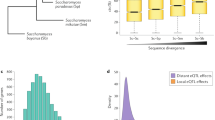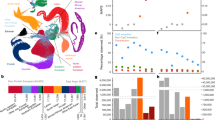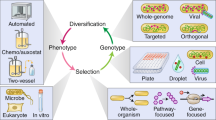Abstract
A principal assumption underlying contemporary genetic analysis is that the normal function of a gene can be inferred directly from its mutant phenotype. The interactivity among genes that is now being revealed calls this assumption into question and indicates that there might be considerable flexibility in the capacity of the genome to respond to diverse conditions. The reservoir for much of this flexibility resides in the nonspecificity and malleability of gene action.
This is a preview of subscription content, access via your institution
Access options
Subscribe to this journal
Receive 12 print issues and online access
$189.00 per year
only $15.75 per issue
Buy this article
- Purchase on Springer Link
- Instant access to full article PDF
Prices may be subject to local taxes which are calculated during checkout


Similar content being viewed by others
References
Allen, G. E. Thomas Hunt Morgan: The Man and His Science (Princeton Univ. Press, Princeton, 1978).
Kohler, R. E. Lords of the Fly: Drosophila Genetics and the Experimental Life (Chicago Univ. Press, Chicago, 1994).
Lawrence, P. Science or alchemy? Nature Rev. Genet. 2, 139–142 (2001).
Judson, J. F. The Eighth Day of Creation (Simon & Schuster, New York, 1979).
Jennings, H. S. Behavior of the Lower Organisms (Indiana Univ. Press, Bloomington, 1906).
Goldschmidt, R. Physiological Genetics (McGraw–Hill, New York, 1938).
Weiss, P. in Analysis of Development (eds Willier, B., Weiss, P. & Hamburger, V.) 346–401 (W. B. Saunders, Philadelphia, 1955).
Morgan, T. H. Genetics and Embryology (Columbia Univ. Press, New York, 1934).
Wright, T. R. F. The genetics of embryogenesis in Drosophila. Adv. Genet. 15, 261–395 (1970).
Hall, J. C. in Flexibility and Constraint in Behavioral Systems (eds Greenspan, R. J. & Kyriacou, C. P.) 15–28 (John Wiley & Sons, New York, 1994).
Pflugfelder, G. O. Genetic lesions in Drosophila behavioural mutants. Behav. Brain Res. 95, 3–15 (1998).
Shaffer, P. Amadeus (Harper & Row, New York, 1980).
Lawrence, P. A. The Making of a Fly (Blackwell Science, Oxford, 1992).
Beadle, G. W. & Tatum, E. L. Genetic control of biochemical reactions in Neurospora. Proc. Natl Acad. Sci. USA 27, 499–506 (1941).
Wood, W. B. & Edgar, R. S. Building a bacterial virus. Sci. Am. 217, 60–74 (1967).
Nusslein-Volhard, C., Frohnhofer, H. G. & Lehmann, R. Determination of anteroposterior polarity in Drosophila. Science 238, 1675–1681 (1987).
Jan, Y. N. & Jan, L. Y. Genetic control of cell fate specification in Drosophila peripheral nervous system. Annu. Rev. Genet. 28, 373–393 (1994).
Leptin, M. Gastrulation in Drosophila: the logic and the cellular mechanisms. EMBO J. 18, 3187–3192 (1999).
Tully, T., Preat, T., Boynton, S. C. & Del Vecchio, M. Genetic dissection of consolidated memory in Drosophila. Cell 79, 35–47 (1994).
Simon, M. A., Botwell, D. L., Dodson, G. S., Laverty, T. R. & Rubin, G. M. Ras1 and a putative guanine nucleotide exchange factor perform crucial steps in signalling by the sevenless protein tyrosine kinase. Cell 67, 701–716 (1991).
O'Kane, C. & Gehring, W. J. Detection in situ of genomic regulatory elements in Drosophila. Proc. Natl Acad. Sci. USA 84, 9123–9127 (1987).
Rorth, P. A modular misexpression screen in Drosophila detecting tissue-specific phenotypes. Proc. Natl Acad. Sci. USA 93, 12418–12422 (1996).
Gerlai, R. Gene-targeting studies of mammalian behavior: is it the mutation or the background genotype? Trends Neurosci. 19, 177–181 (1996).
de Belle, J. S. & Heisenberg, M. Expression of Drosophila mushroom body mutations in alternative genetic backgrounds: a case study of the mushroom body miniature gene (mbm). Proc. Natl Acad. Sci. USA 93, 9875–9880 (1996).
Osborne, K. A. et al. Natural behavior polymorphism due to a cGMP-dependent protein kinase of Drosophila. Science 277, 834–836 (1997).
Greenspan, R. J. A kinder, gentler genetic analysis of behavior: dissection gives way to modulation. Curr. Opin. Neurobiol. 7, 805–811 (1997).
Pereira, H. S., Macdonald, D. E., Hilliker, A. J. & Sokolowski, M. B. Chaser (Csr), a new gene affecting larval foraging behavior in Drosophila melanogaster. Genetics 141, 263–270 (1995).
Griffith, L. C., Wang, J., Zhong, Y., Wu, C. F. & Greenspan, R. J. Calcium/calmodulin-dependent protein kinase II and potassium channel subunit eag similarly affect plasticity in Drosophila. Proc. Natl Acad. Sci. USA 91, 10044–10048 (1994).
Fedorowicz, G. M., Fry, J. D., Anholt, R. R. & Mackay, T. F. Epistatic interactions between smell-impaired loci in Drosophila melanogaster. Genetics 148, 1885–1891 (1998).
Clark, A. G. & Wang, L. Epistasis in measured genotypes: Drosophila P-element insertions. Genetics 147, 157–163 (1997).
Greenspan, R. J. & Tully, T. in Flexibility and Constraint in Behavioral Systems (eds Greenspan, R. J. & Kyriacou, C. P.) 65–80 (Dahlem Konferenzen, Berlin, 1994).
Cooke, J., Nowak, M. A., Boerlijst, M. & Maynard-Smith, J. Evolutionary origins and maintenance of redundant gene expression during metazoan development. Trends Genet. 13, 360–362 (1997).
Misawa, H. et al. Contrasting localizations of MALS/LIN-7 PDZ proteins in brain and molecular compensation in knockout mice. J. Biol. Chem. 276, 8264–9272 (2001).
Tononi, G., Sporns, O. & Edelman, G. M. Measures of degeneracy and redundancy in biological networks. Proc. Natl Acad. Sci. USA 96, 3257–3262 (1999).
Edelman, G. M. in The Mindful Brain (eds Edelman, G. M. & Mountcastle, V. B.) 51–100 (MIT Press, Cambridge, Massachusetts, 1978).
Edelman, G. M. Topobiology (Basic Books, New York, 1989).
Wodicka, L., Dong, H., Mittmann, M., Ho, M.-H. & Lockhart, D. J. Genome-wide expression monitoring in Saccharomyces cerevisiae. Nature Biotechnol. 15, 1359–1367 (1997).
Futcher, B., Latter, G. I., Monardo, P., McLaughlin, C. S. & Garrels, J. I. A sampling of the yeast proteome. Mol. Cell Biol. 19, 7357–7368 (1999).
Livesey, F. J., Furukawa, T., Steffen, M. A., Church, G. M. & Cepko, C. L. Microarray analysis of the transcriptional network controlled by the photoreceptor homeobox gene Crx. Curr. Biol. 10, 301–310 (2000).
Barkai, N & Leibler, S. Robustness in simple biochemical networks. Nature 387, 913–917 (1997).
Bhalla, U. S. & Iyengar, R. Emergent properties of networks of biological signaling pathways. Science 283, 381–387 (1999).
Harwood, J. Styles of Scientific Thought: The German Genetics Community 1900–1933 (Chicago Univ. Press, Chicago, 1993).
Gould, S. J. & Lewontin, R. C. The spandrels of San Marco and the Panglossian paradigm: a critique of the adaptationist programme. Proc. R. Soc. Lond. B 205, 581–598 (1979).
Farah, M. J. Neuropsychological inference with an interactive brain: a critique of the 'locality' assumption. Behav. Brain Sci. 17, 43–61 (1994).
Dudai, Y., Jan, Y.-N., Byers, D., Quinn, W. G. & Benzer, S. dunce, a mutant of Drosophila deficient in learning. Proc. Natl Acad. Sci. USA 73, 1684–1688 (1976).
Byers, D., Davis, R. L. & Kiger, J. A. Jr Defect in cyclic AMP phosphodiesterase due to the dunce mutation of learning in Drosophila melanogaster. Nature 289, 79–81 (1981).
Bellen, H. J., Gregory, B. K., Olsson, C. L. & Kiger, J. A. Jr Two Drosophila learning mutants, dunce and rutabaga, provide evidence of a maternal role for cAMP in embryogenesis. Dev. Biol. 121, 432–444 (1987).
Boynton, S. & Tully, T. latheo, a new gene involved in associative learning and memory in Drosophila melanogaster. Genetics 131, 655–672 (1992).
Pinto, S. et al. latheo encodes a subunit of the origin recognition complex and disrupts neuronal proliferation and adult olfactory memory when mutant. Neuron 23, 45–54 (1999).
Heisenberg, M., Wonneberger, R. & Wolf, R. optomotor-blindH31 — a Drosophila mutant of the lobula plate giant neurons. J. Comp. Physiol. A 124, 287–296 (1978).
Pflugfelder, G. O. et al. The lethal(1)optomotor-blind gene of Drosophila melanogaster is a major organizer of optic lobe development: isolation and characterization of the gene. Proc. Natl Acad. Sci. USA 89, 1199–1203 (1992).
Kopp, A. & Duncan, I. Control of cell fate and polarity in the adult abdominal segments of Drosophila by optomotor-blind. Development 124, 3715–3726 (1997).
Wu, C.-F., Ganetzky, B., Jan, L. Y., Jan, Y.-N. & Benzer, S. A Drosophila mutant with a temperature-sensitive block in nerve conduction. Proc. Natl Acad. Sci. USA 75, 4047–4051 (1978).
Lee, C. G., Chang, K. A., Kuroda, M. I. & Hurwitz, J. The NTPase/helicase activities of Drosophila maleless, an essential factor in dosage compensation. EMBO J. 16, 2671–2681 (1997).
Kernan, M. J., Kuroda, M. I., Kreber, R., Baker, B. S. & Ganetzky, G. napts, a mutation affecting sodium channel activity in Drosophila, is an allele of mle, a regulator of X chromosome transcription. Cell 66, 949–959 (1991).
Pak, W. L., Grossfield, W. J. & Arnold, K. S. Mutants of the visual pathway of Drosophila melanogaster. Nature 227, 518–520 (1970).
Bloomquist, B. T. et al. Isolation of a putative phospholipase C gene of Drosophila, norpA, and its role in phototransduction. Cell 54, 723–733 (1988).
Dushay, M. S., Rosbash, M. & Hall, J. C. The disconnected visual system mutations in Drosophila melanogaster drastically disrupt circadian rhythms. J. Biol. Rhythms 4, 1–27 (1989).
Riesgo-Escovar, J., Raha, D. & Carlson, J. R. Requirement for a phospholipase C in odor response: overlap between olfaction and vision in Drosophila. Proc. Natl Acad. Sci. USA 92, 2864–2868 (1995).
Acknowledgements
Helpful comments on the manuscript were provided by C. Deutsch, G. Edelman, J. Gally, J. Hall and F. Jones, for which I am very grateful. I thank K. McCarthy for assistance with Latin grammar.
Author information
Authors and Affiliations
Related links
Related links
DATABASE LINKS
ENCYCLOPEDIA OF LIFE SCIENCES
Rights and permissions
About this article
Cite this article
Greenspan, R. The flexible genome. Nat Rev Genet 2, 383–387 (2001). https://doi.org/10.1038/35072018
Issue Date:
DOI: https://doi.org/10.1038/35072018
This article is cited by
-
Kinds of modalities and modeling practices
Synthese (2023)
-
Aging-Related Variation of Cuticular Hydrocarbons in Wild Type and Variant Drosophila melanogaster
Journal of Chemical Ecology (2022)
-
The guanine nucleotide exchange factor Net1 facilitates the specification of dorsal cell fates in zebrafish embryos by promoting maternal β-catenin activation
Cell Research (2017)
-
A substrate ambiguous enzyme facilitates genome reduction in an intracellular symbiont
BMC Biology (2014)
-
Statistical method for mapping QTLs for complex traits based on two backcross populations
Chinese Science Bulletin (2012)



